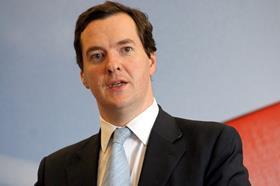George Osborne to admit the PFI school programme is now worth £1.75bn, rather than the £2bn originally announced

The government is set to cut the PFI element of its flagship school building programme by more than 10% to £1.75bn, ��ɫ����TV can reveal.
The Priority Schools ��ɫ����TV Programme (PSBP) is expected to be the first to be identified as using the revamped PFI funding route, to be called PF2, which will be unveiled when George Osborne makes his Autumn Statement on Wednesday (5 December).
However, ��ɫ����TV understands that the announcement will also be used to slip out the news that the total estimate for the construction cost of the schools in the PFI part of the programme has fallen from £2bn to £1.75bn.
The £1.75bn figure includes the capital cost of building the schools and the costs of fittings and equipment.
Government sources insist the move simply reflects a more recent and therefore more specific estimate of the value of the schemes expected to take part in the priority schools programme, and that no schemes have been dropped from the programme.
However, when education secretary Michael Gove announced the programme in July 2011 he said it would be worth “around £2bn in up-front construction costs”.
A government source said: “The £2bn figure was an early estimate of the value of the programme. We now know how many schools will be involved hence more specific, accurate costing. Nothing has been cut.
“Over the life of the PFI contracts there will be considerable extra investment from maintaining the schools that are built.”
However, maintenance spending is separate to capital investment and contractors waiting for news on the programme may ask why new schemes haven’t been added in to the programme if either project costs have reduced or possible schemes fallen away.
The Department for Education referred inquiries to the Treasury.
For more details on the new PF2 programme,
The news is expected to come as Osborne outlines revisions to PFI contracts that will see the government take equity stakes in the projects, a limit on the time period for procurement of project teams, and greater transparency requirements on project companies.
Meanwhile, the government is planning further cuts to Whitehall departments in order to fund £5bn of capital spending over the next two years on infrastructure projects, including on transport and schools.
The government said £1bn of the capital boost would be focused on school building, including up to 100 academies and free schools.
Government sources said the £1bn would also been used to fund the expansion of existing schools, including maintained schools.
It is understood that the funding will be treated as an entirely new funding pot, managed by the Department for Education, with local authorities expected to bid into the fund.
It is understood the fund will be demand driven, with awards made on a needs-basis, with population-pressure the key determining factor. “This is about creating places where the need is greatest,” a government source said. “It is about new schools, but also about expanding existing schools.”
Speaking to Sky ��ɫ����TV today, David Cameron the remaining £4bn of the capital boost would be focused on other infrastructure, including roads, Further Education Colleges, and hospitals.
He said: “If you look at departmental budgets, they’re not actually spending up to the totals they’ve been allotted, so we can take some of that money and cut out any wasteful spending as well, always looking for further efficiency and spend that money on the schools, the roads, the hospitals, the Further Education Colleges, things that will help our society but also things that will make our economy more productive.”
The £5bn funding is expected to come from further cuts to Whitehall departments, with government departments, excluding health, education, and international development, to be asked to save an additional 1% next year, and 2% in 2014-15.
Number 10 said: “The switch from current spending to capital spending at this Autumn Statement is a continuation of the government’s strategy and follows a similar switch of £5bn at the last Autumn statement and an additonal £2bn a year of capital spending announced in the spending review.
Number 10 said the £5bn of capital investment funding would be allocated over the next two years.
The move comes as the first details of the government’s revamped PFI programme emerged today.
a hospital project in Birmingham is expected to be one of the first schemes set to benefit from the ‘son of PFI’, rebranded asPF2, along with defence projects and the government’s priority schools programme.
For more details on the new PF2 programme,



























No comments yet